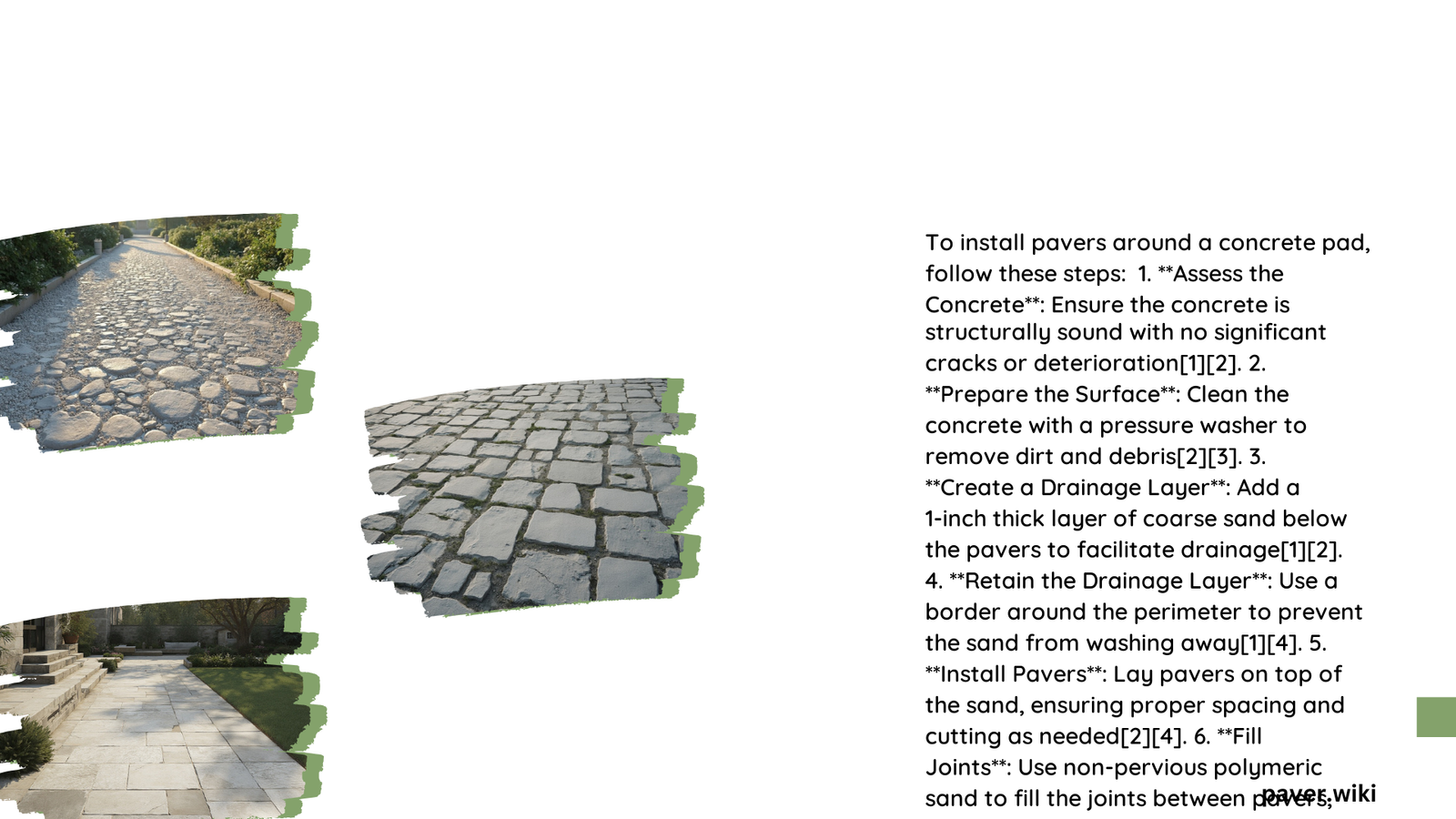Pavers around concrete pads offer a versatile and aesthetically pleasing solution for enhancing outdoor spaces. This guide explores the various aspects of installing pavers around concrete pads, including types of pavers, installation processes, drainage solutions, and maintenance requirements. Whether you’re looking to upgrade your patio, driveway, or walkway, understanding these key elements will help you create a durable and attractive paved area that complements your existing concrete structure.
What Types of Pavers Are Best for Installation Around a Concrete Pad?
When selecting pavers for installation around a concrete pad, it’s crucial to consider both functionality and aesthetics. The right choice can enhance the overall look of your outdoor space while providing durability and ease of maintenance.
Material Options and Their Characteristics
- Concrete Pavers
- Versatile and available in various sizes and colors
- Durable and cost-effective
- Sizes: 12\” x 12\”, 16\” x 16\”, 24\” x 24\”, and smaller options like 6\” x 6\” or 8\” x 8\”
-
Ideal for large patios, walkways, and driveways
-
Brick Pavers
- Offer a classic, traditional look
- Standard sizes: 4\” x 8\” and 2 3/8\” x 8\”
-
Commonly used for driveways, walkways, and patios
-
Stone Pavers
- Provide a natural, elegant appearance
- Sizes: 12\” x 12\”, 16\” x 16\”, 24\” x 24\”, and smaller options
-
Suitable for creating a rustic or high-end look
-
Travertine Pavers
- Known for their unique patterns and cool surface
- Common sizes: 8\” x 8\”, 8\” x 16\”, and 16\” x 16\”
- Smaller sizes like 4\” x 4\” or 6\” x 6\” also available
Aesthetic Compatibility Considerations
- For a traditional look, consider brick pavers or smaller concrete pavers
- For a contemporary design, opt for larger format concrete or stone pavers
- Ensure the chosen pavers complement the architecture of the surrounding area and the concrete pad itself
How to Install Pavers Around a Concrete Pad?

Installing pavers around a concrete pad requires careful planning and execution. Follow these steps to ensure a successful installation:
Tools and Materials Needed
- Shovel or trenching shovel
- Level
- Rake
- Plate compactor or hand tamper
- Paver saw or wet saw
- Notched trowel
- Sand or paver base material
- Geotextile fabric (optional)
- Edging material (plastic or metal)
Step-by-Step Installation Process
- Measure and Mark the Area
-
Use stakes and string to outline the area around the concrete pad
-
Excavate the Area
-
Dig to a depth of 8-10 inches, depending on paver thickness and base material
-
Prepare the Base
- Lay geotextile fabric (if using) to prevent weed growth and stabilize the base
- Fill with 4-6 inches of compacted gravel or paver base material
-
Add a 1-2 inch layer of sand and level it
-
Install Edging
-
Place edging material around the perimeter to keep pavers in place
-
Lay Pavers
- Start from one corner, using a level and string line for alignment
- Cut pavers as needed using a paver saw or wet saw
-
Maintain 1/8 to 1/4 inch joint spacing between pavers
-
Compact and Finish
- Use a plate compactor or hand tamper to secure pavers after each row
- Fill joints with sand or polymeric sand for stability and drainage
What Are Effective Drainage Solutions for Pavers Around Concrete Pads?
Proper drainage is essential to prevent water pooling and potential damage to both the pavers and the concrete pad. Consider these drainage solutions:
Slope Requirements
- Ensure a minimum slope of 1-2% (1/8 inch per foot) away from the concrete pad
Drainage Materials
- Sand
- Use polymeric sand or regular sand to fill joints between pavers
-
Polymeric sand offers better weed prevention and paver stabilization
-
Geotextile Fabric
-
Install under the paver base to improve drainage and prevent weed growth
-
Permeable Pavers
- Consider using these specialized pavers that allow water to pass through, reducing the need for extensive drainage systems
Installation Techniques for Proper Drainage
- Base Preparation
-
Ensure a well-compacted, sloped base to direct water away from the concrete pad
-
Drainage Channels
-
Install French drains or drainage channels if necessary to redirect water
-
Regular Maintenance
- Clean pavers and maintain joint sand to ensure continued proper drainage
How to Maintain Pavers Adjacent to Concrete?
Regular maintenance is key to preserving the appearance and functionality of pavers around concrete pads. Follow these guidelines:
Cleaning Frequency and Methods
- Clean pavers at least twice a year, or more often in high-traffic areas
- Use mild detergent and water, avoiding harsh chemicals that can damage pavers or joint sand
Sealing Products and Application
- Choose water-based or solvent-based sealers designed for concrete or stone pavers
- Apply sealer according to manufacturer’s instructions after cleaning and drying pavers
- Reseal every 2-5 years, depending on traffic and exposure to elements
Repair Techniques
- Replacing Damaged Pavers
- Remove the damaged paver, clean the area, and insert a new one
-
Compact and fill joints with sand
-
Joint Maintenance
-
Regularly inspect and refill joint sand to maintain stability and prevent weed growth
-
Leveling
- Periodically check for uneven settling and make necessary adjustments
By following these guidelines for selection, installation, drainage, and maintenance of pavers around concrete pads, you can create a beautiful and long-lasting outdoor space that enhances your property’s value and functionality.
